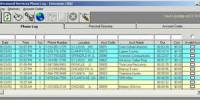Definitions of Debits and Credits-Lecture
Debit
- An entry in the financial books of a firm that increases an asset or an expense or an entry that decreases a liability, owner’s equity (capital) or income.
- Also, an entry entered on the left side (column) of a journal or general ledger account.
- Let’s combine the two above definitions into one complete definition.
An entry (amount) entered on the left side (column) of a journal or general ledger account that increases an asset, draw or an expense or an entry that decreases a liability, owner’s equity (capital) or revenue.
Credit
- An entry in the financial books of a firm that increases a liability, owner’s equity (capital) or revenue, or an entry that decreases an asset or an expense.
- Also, an entry entered on the right side (column) of a journal or general ledger account.
- Let’s combine the two above definitions into one complete definition.
An entry (amount) entered on the right side (column) of a journal or general ledger account that increases a liability, owner’s equity (capital) or revenue, or an entry that decreases an asset, draw, or an expense.
The term debit refers to the left side of an account and credit refers to the right side of an account. A debit is always entered in the left hand column of a Journal or Ledger Account and a credit is always entered in the right hand column. Debit is abbreviated Dr. and Credit is abbreviated Cr.
When you post (record) an entry in the left hand column of an account you are debiting that account. Whether the debit is an increase or decrease depends on the type of account. Likewise, when you post (record) an entry in the right hand column of an account you are crediting that account. Whether the credit is an increase or decrease depends on the type of account.
Rules For Determining Debit and Credit :
The three basic rules about recording transactions are:
1: Total asset= Total liab + owner’s Equity
2: Debit: all exp & loss
Credit: all income & gain
3: Total of debit side = Total of credit side
There 3 basic rules in Accounting:
1. Debit to receiver
Credit to giver
2. Debit what comes in
Credit what goes out
3. Debit All Exp /Loss
Credit Income/Gain
Basic rules in Accounting:
1.personal account
debit the receiver
credit the giver
2.nominal account
all expense and loses debit
all incomes and gains credit
3.real account
what comes in debit
what goes out credit There 3 basic rules in Accounting
There 3 basic rules in Accounting:
1.Real Account
what comes in Dr
what goes out Cr
2.Personal Account
The Recover Dr
Giver Cr
3.Nominal Account
All Expenses Dr
All incomes Cr
Three rules are :
1. real a/c i.e. (asset)
when one asset comes in it should be debited
when one asset goes out it should be credited
2.personal a/c i.e. (individual a/c)
when one person or co. Receives benefit it should debited
when one person or co. Gives benefit it should be credited
3.nominal a/c
all the expenses losses should be debited
all the incomes gains should be credited
Three types of rule:
1.personal a/c: dt: the receiver
cr: the giver
2.real a/c : dt: what comes in
cr: what goes out
3.nominal a/c : dt: all exp & loss
How To Use and Apply The Debit and Credit Rules:
(1) Determine the types of accounts the transactions affect-asset, liability, revenue, expense or draw account.
(2) Determine if the transaction increases or decreases the account’s balance.
(3) Apply the debit and credit rules based on the type of account and whether the balance of the account will increase or decrease.
Our Simple Debit / Credit Rule:
- All Accounts that Normally Have a Debit Balance are Increased with a Debit by placing the amount in the Left Column of the account and Decreased with a Credit by placing the amount in the Right Column of the account.
- Assets
- Draws
- Expenses
- All Accounts that Normally have a Credit Balance are Increased with a Credit by placing the amount in the Right Column of the account and Decreased with a Debit by placing the amount in the Left Column of the account.
- Liabilities
- Owner’s Equity ( Capital )
- Revenue
Enter an amount in the Normal Balance Side of an Account to Increase the Balance of an Account and in the Opposite Side of an Account to Decrease the Balance of an Account. |
Additional Clarification:
Since Assets, Draw, and Expense Accounts normally have a Debit Balance, in order to Increase the Balance of an Asset, Draw, or Expense Account enter the amount in the Debit or Left Side Column and in order to Decrease the Balance enter the amount in the Credit or Right Side Column.
Likewise, since Liabilities, Owner’s Equity (Capital), and Revenue Accounts normally have a Credit Balance in order to Increase the Balance of a Liability, Owner’s Equity, or Revenue Account the amount would be entered in the Credit or Right Side Column and the amount would be entered in the Debit or Left Side column to Decrease the Account’s Balance.
The Debit and Credit Rules Presented as A Table
| Account Type | Normal Balance | Increase To Account Balance | Decrease To Account Balance | Account Example |
| Property Accounts | ||||
| Asset | Debit | Debit – Left Column Of Account | Credit – Right Column Of Account | Cash, Accounts Receivable |
| Property Rights Accounts | ||||
| Liability | Credit | Credit – Right Column Of Account | Debit – Left Column Of Account | Accounts Payable |
| Owner’s Equity | Credit | Credit – Right Column Of Account | Debit – Left Column Of Account | Owner’s Capital |
| Revenue | Credit | Credit – Right Column Of Account | Debit – Left Column Of Account | Sales |
| Costs and Expenses | Debit | Debit – Left Column Of Account | Credit – Right Column Of Account | Rent, Utilities, Advertising |
| Owner Draws | Debit | Debit – Left Column Of Account | Credit – Right Column Of Account | Owner Draws |
Typical Types Of Business Transactions
and the Debits and Credits and Accounts Used To Record Them
In a typical business transaction we get something and we give up something.
Sale-Sell goods and/or services
- (1) Cash Sale-customer pays at the time of sale
The business gets cash or a check from their customer and gives up a product or service to their customer.
Accounts Used:
Debit: Cash
Credit: Sales - (2) On Account Sale-business allows the customer time to pay
The business gets a promise to pay from their customer and gives up a product or service to their customer.
Accounts Used:
Debit: Accounts Receivable
Credit: Sales
Purchase goods and/or services
- (3) Cash Purchase-business pays the supplier at the time of purchase
The business gets a product or service from their supplier and gives up cash or a check to their supplier.
Accounts Used:
Debit: Expense or Inventory Account
Credit: Cash - (4) On Account Purchase-supplier allows the business time to pay
The business gets a product or service from a supplier and gives up a promise to pay to their supplier.
Accounts Used:
Debit: Expense or Inventory Account
Credit: Accounts Payable
(5) Pay Supplier Charge Purchases -pay suppliers for products and/or services that we promised to pay for later (charge).
The business gets the amount of their promise to pay the supplier reduced and gives up cash or a check.
Accounts Used:
Debit: Accounts Payable
Credit: Cash
(6) Receive Customer Charge Payments -receive payments from a customer that promised to pay us later (charge sale).
The business gets cash or a check from their customer and gives up (reduces the amount of) their customer’s promise to pay.
Accounts Used:
Debit: Cash
Credit: Accounts Receivable
(7) Borrow Money (Loans) The business gets cash or equipment and gives up a promise to pay.
Accounts Used:
Debit: Cash or Equipment
Credit: Note Payable
(8) Repay a Loan
The business gets the amount of their promise to pay reduced and gives up cash or a check.
Accounts Used:
Debit: Note Payable
Credit: Cash
(9) Draw
The business gets the owner’s claim to the business assets reduced and gives up cash or a check.
Accounts Used:
Debit: Owner’s Draw
Credit: Cash
(10) Payroll (not covered in this tutorial)
The business gets services from their employees and gives up a check.
Accounts Used:
Debit: Salary & Wages Expense
Credit: Cash
Type Of Accounts
In prior lessons, we mainly used “The Big Three” (Assets, Liabilities, and Owner’s Equity) and “Ma Capital’s (Owners Equity) Kids” (Revenue, Expense, Investment, and Draws) as our “accounts” to learn how business transactions affect account balances.
These seven “big” type of accounts were defined in Lesson 1 as follows:
Assets
Formal Definition:The properties used in the operation or investing activities of a business.
Informal Definition:All the good stuff a business has (anything with value). The goodies.
Liability
Formal Definition:Claims by creditors to the property (assets) of a business until they are paid.
Informal Definition:Other’s claims to the business’s stuff. Amounts the business owes to others.
Owner’s Equity also called Owner’s Capital
Formal Definition:The owner’s rights to the property (assets) of the business; also called proprietorship and net worth.
Informal Definition:What the business owes the owner. The good stuff left for the owner assuming all liabilities (amounts owed) have been paid.
“Ma Capital’s (Owner’s Equity) Four Kids”
- Revenue
Formal Definition:The gross increase in owner’s equity resulting from the operations and other activities of the business.
Informal Definition:Amounts a business earns by selling services and products. Amounts billed to customers for services and/or products. - Expense
Formal Definition:Decrease in owner’s equity resulting from the cost of goods, fixed assets, and services and supplies consumed in the operations of a business.
Informal Definition:The costs of doing business. The stuff we used and had to pay for or charge to run our business. - Draws
Formal Definition: Decrease in owner’s equity resulting from withdrawals made by the owner.
Informal definition: Amounts the owner withdraws from his business for living and personal expenses. - Owner’s Investments
Formal Definition: Increase in owner’s equity (capital) resulting from additional investments of cash and/or other property made by the owner.
Informal definition: Additional amounts, either cash or other property, that the owner puts in his business.
In the real bookkeeping world, we want to know the detail types of assets, liabilities, equity (capital), revenues, expenses, and draws.
In Lesson 1 we discussed some of the detail types of assets, liabilities, equity, revenue, and expenses. Can You name a few ? I’ll help you.
Examples of Assets-Cash, Accounts Receivable, Notes Receivable, Buildings, and Equipment
Examples Of Liabilities-Accounts Payable, Notes Payable, and Mortgage Payable
Examples Of Revenue-Product Sales, Rental Income, and Service Revenue
Examples Of Expenses-Employee Wages, Building Rental, Telephone, Utilities, Advertising, Office Supplies
Rules for Debits and Credits that we will use in this lesson were just covered in Lesson 3. If you’ve slept since then, the following procedure is what you use in order to use and apply the Debit and Credit Rules when recording bookkeeping transactions.
How To Use and Apply The Debit and Credit Rules:
(1) Determine the type of account(s) the transactions affect-asset, liability, revenue, or expense account.
(2) Determine if the transaction increases or decreases the account’s balance.
(3) Apply the debit and credit rules based on the type of account and whether the balance of the account will increase or decrease.
Let’s revisit another definition and term that was defined in Lesson 1 and discussed in Lesson 3.
Account-a separate record for each type of asset, liability, equity, revenue, and expense used to show the beginning balance and to record the increases and decreases for a period and the resulting ending balance at the end of a period.
Any of these or any others that our business needs or wants to track have their own separate and individual account. What officially do we call this detail listing of accounts that we set up for our business ? Simply a Chart Of Accounts.
In this lesson and future lessons we are going to stray away from analyzing and recording transactions using the “Big Accounts” and start using the detail accounts to record and analyze our business transactions.
Let’s take a step in this direction by setting up a simple chart of accounts for ABC Mowing.
Simple Chart Of Accounts For ABC Mowing
| Assets Account Name:Cash Description:Currency and checks and balance in bankAccount Name:Accounts Receivable Description:Amounts due from customer’s for services renderedAccount Name:Inventory-Office Supplies Description:On hand supplies of such items as copier & computer paper, pens, pencils and other office suppliesAccount Name:Mowing Equipment Description:Mowers purchased Liabilities Account Name:Note Payable-Bank | Equity Account Name:Owner’s Capital Description:Amounts invested by owner and earned by operationsAccount Name:Owner’s Draws Description:Amounts withdrawn by owner for personal expensesRevenue Account Name:Mowing Revenues Description:Earnings from mowing yardsExpenses Account Name:Advertising Expense Description:Expenditures for TV, radio, newspaper, and other promotions. Account Name:Mulch Expense |
In order to record the information in our accounts, we also need to be familiar with the source documents that provide us with the necessary information for recording our transactions.
Source Documents
The original sources of information that provide documentation (proof) that a transaction has occurred are sales invoices (tickets), invoices from suppliers, contracts, checks written and checks received , promissory notes, and various other types of business documents. These documents provide us with the information needed to record our financial transactions in our bookkeeping records.
Typical Types Of Business Transactions
and the Debits and Credits and Accounts Used To Record Them
In a typical business transaction we get something and we give up something.
T-Accounts Notice that Assets, Draws, and Expense Type of Accounts are increased using the Left Side (Column) of the account (debited) and decreased using the Right Side (Column) of the account (credited). The reverse is true for the Liability, Equity, and Revenue Type of Accounts. These Type Of Accounts are increased using the Right Side (Column) of the account (credited) and decreased using the Left Side (Column) of the account (debited).
Now, I think we should be ready to revisit our ABC Mowing Company and record the transactions presented in prior lessons in our detailed accounts (T-Accounts). We are going to assume that ABC has beginning balances already recorded in their accounts. We are going to assume that ABC has balances already recorded in their accounts. These balances are as of December 1, xxxx. Note: If these balances were as of the beginning of the year the nominal or temporary accounts – revenues, expenses, and draws would all have zero balances. Lastly, we are going to thoroughly review each transaction for December xxxx and show you the hows and whys to properly recording each transaction and present the steps for properly analyzing and recording a transaction. ABC’s Beginning Account Balances as of December 1, xxxx
Notice I used the symbols Dr and Cr to abbreviate the Debit and Credit balances in the table of ABC’s beginning balances. While this is a common method of representing debits and credits, other symbols that we discussed in Lesson 3 are also used. You’d better check me out to see if our books balance before we start recording ABC’s transactions. We’re going to perform two checks that relate to what we’ve been learning in prior lessons. The first check is to see if our Accounting Equation balances and the second to make sure that the debit balances equal the credit balances. Equation Check Calculations Total Assets = Cash + Accounts Receivable + Mowing Equipment Total Liabilities is easy because there is only one account (Accounts Payable) with a balance of 2,000. Total Equity = Owner’s Capital + Revenues – Expenses – Draws Total Equity = Owner’s Capital + Revenues – Expenses – Draws Substituting our totals into the Accounting Equation we find that our equation balances.
Our second check is to see if our debit account balances equal our credit account balances. Let’s total our Debit Balances
Now we’ll total our Credit Balances
| |||||||||||||||||||||||||||||||||||||||||||||||||||||||||||||||||||||||||||||||||||||||||||||||||||||||||||||||||||||||||||||||||||||||||||||||||||||||||||||||||||||||||||||||||||||||||||||||||
















